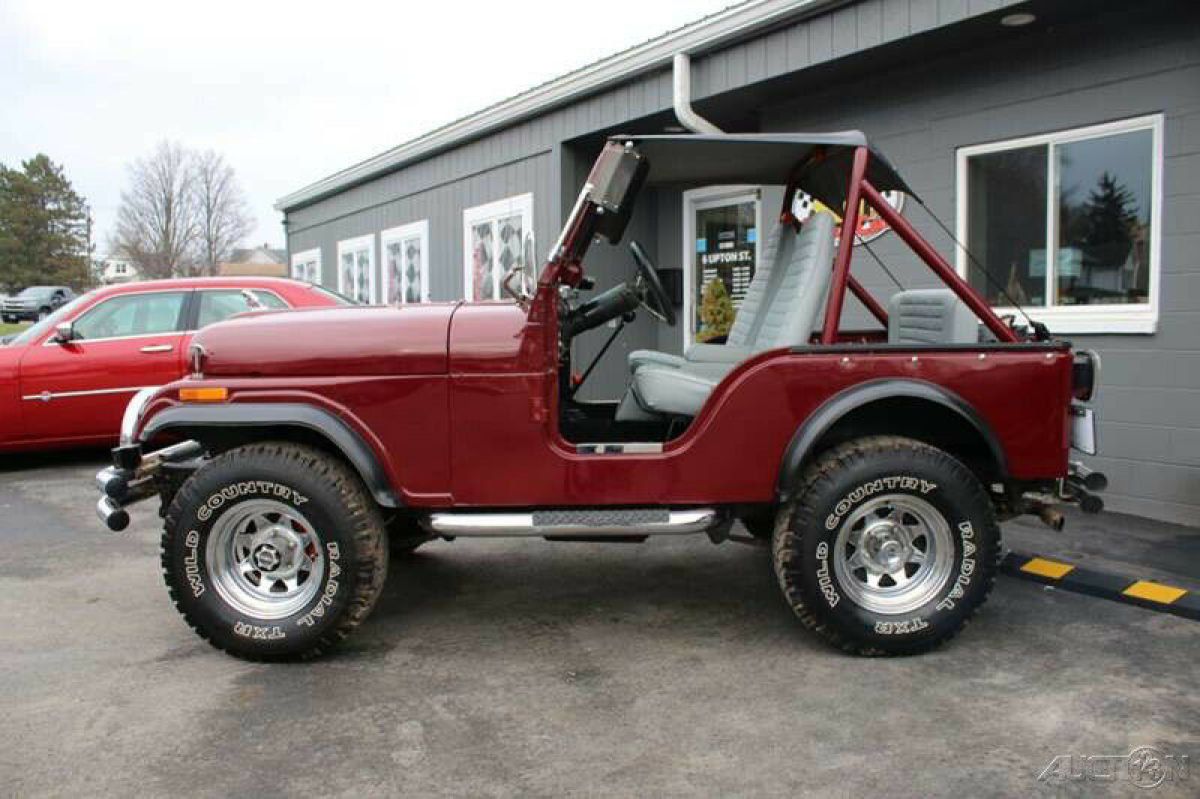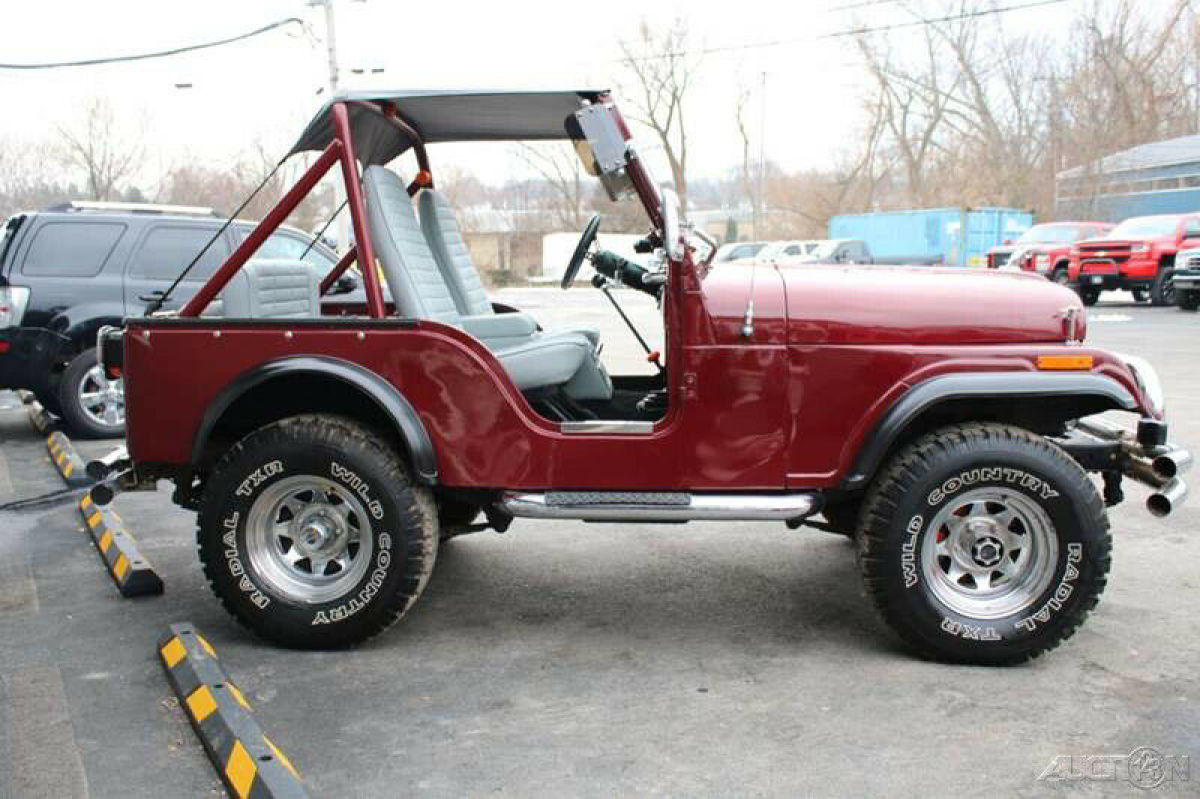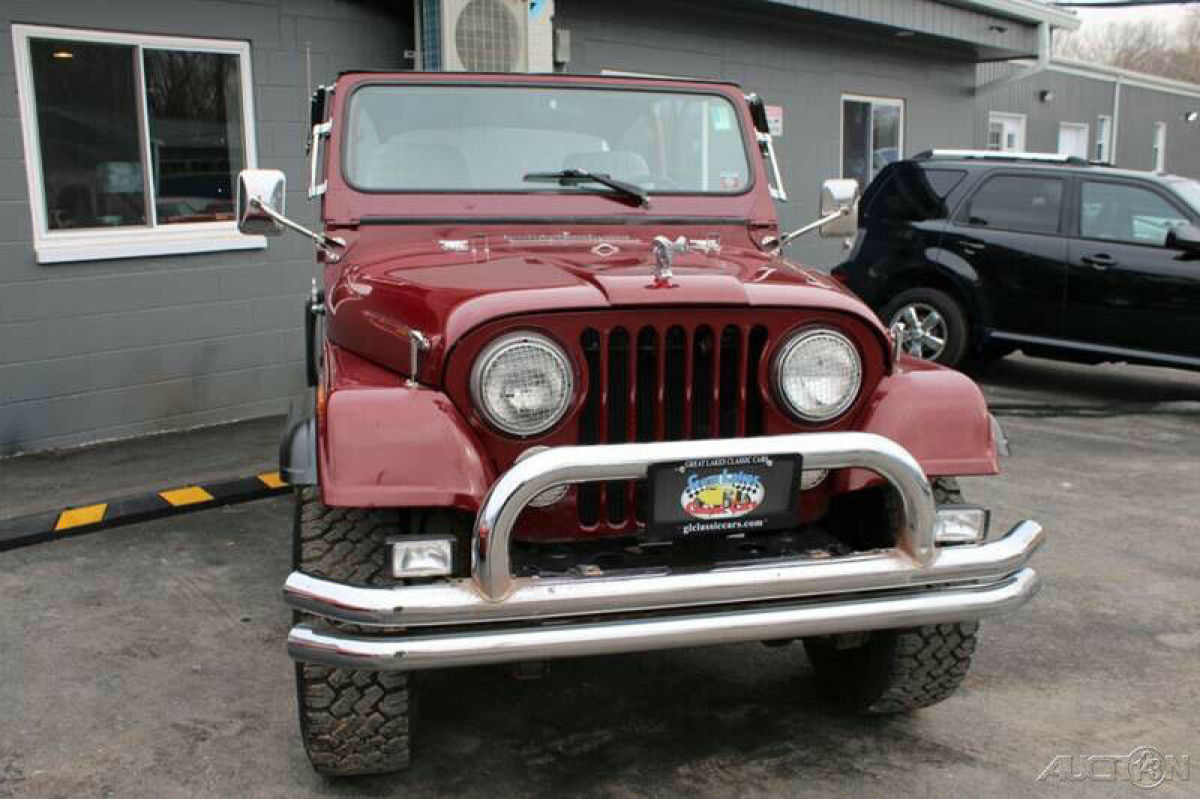1978 AMC JEEP CJ5 Soft Top I-6 Manual Transmission 4WD
1978 Jeep CJ CJ5
Technical specifications of Jeep CJ 1978 | |
|---|---|
| Price: | - |
| Item location: | Hilton, New York, United States |
| Make: | Jeep |
| Model: | CJ |
| SubModel: | AMC JEEP |
| Type: | Convertible |
| Trim: | CJ5 |
| Doors: | 2 Doors |
| Year: | 1978 |
| Mileage: | 60517 |
| VIN: | 0000J8F83AA143463 |
| Color: | Burgundy |
| Engine size: | I6 4.0L |
| Number of cylinders: | 6 |
| Fuel: | Gasoline |
| Transmission: | Manual |
| Drive type: | 4WD |
| Interior color: | Gray |
| Vehicle Title: | Clear |
| You are interested? | Contact the seller! |
Car description |
|---|
From 1961 to 1965, optional for the CJ-5 and CJ-6 was the British-madePerkins192cuin (3.15L) Diesel I4 with 62hp (46kW) at 3,000rpm and 143lb/ft (213kg/m) at 1350rpm.
In 1965, Kaiser bought license to produce theBuick225cuin (3.7L) V6Dauntlessengine, to offer the new 155hp (116kW) option on the CJ-5 and CJ-6, countering complaints that the 75hpfour-cylinderWillys Hurricane engine was underpowered. Power steering was a $81 option.The V6 engine proved so popular, by 1968, some 75% of CJ-5s were sold with it.
Kaiser Jeep was sold toAmerican Motors Corporation(AMC) in 1970, and the Buick engine was retired after the 1971 model year. (GM'sBuickdivision repurchased the engine tooling in the early 1970s which served as the powerplant in several GM vehicles.) The "Trac-Lok"limited-slip differentialreplaced the "Powr-Lok" in 1971, and PTOs were no longer available after that year.[46]AMC began marketing the Jeep less as a universal utility vehicle, and more as a sporty one, notably increasing its performance and features.
1972 RevampThe 1972 model year brought significant changes to the CJ-5. American Motors began fitting their own engines, which also required changes to both body and chassis. The base Willys 4-cylinder was replaced by AMC's Torque Command straight-6 engines, giving the entry-level CJ-5 the power of the previously optional Buick V6. Standard became the 232cuin (3.8L), and optional the 258cuin (4.2L), which was standard in California. Both engines used a one-barrel Carter YF carburetor. Also in 1972,AMC's 304cuin (5.0L) V8engine became available, which upgraded thepower-to-weight ratioto a level comparable to a V8 muscle-car. Other drive-train changes included a new front axle - a full-floating, open-knuckleDana 30, which was both 25lbs lighter and reduced the turning circle by 6ft.
To accommodate the new engines, the wheelbase was stretched by 3in (76mm), and the fenders and hood were stretched by 5in (127mm), pushing the firewall two inches closer to the rear.A new box-frame was fitted, featuring six cross-members for more rigidity.Also, a larger fuel tank was mounted, moved from under the driver's seat to under the rear, between the frame rails.
In 1973, a new dash was introduced, with a single gauge in the center of the dash housing the speedometer and fuel and temperature gauges.
A factory-installed radio became available in 1973, air conditioning became available via dealership in 1975, also electronic ignition for the full engine line-up, and a catalytic converter on the V8.
In 1975, for the 1976 model year, the tub and frame were modified from earlier versions. The frame went from a partially open channel/boxed frame with riveted crossmembers, to majoritively boxed with welded crossmembers, and from parallel rails to widening fore to aft to benefit stability.and the body tub became more rounded. The windshield frame and windshield angle were also changed, meaning that tops from 1955 to 1975 will not fit a 1976-1983 CJ-5 and vice versa. The rear axle was also changed in 1976 from aDana 44to an AMC-manufacturedmodel 20that had a larger-diameter ring gear, but used a two-piece axleshaft/hub assembly instead of the one-piece design used in the Dana.
For 1977, the frame was modified again to a completely boxed unit. Power disc brakes and the "Golden Eagle" package (which included a tachometer and clock) were new options,[10]as well as air conditioning.
In 1979, the standard engine became the 258cuin (4.2L) I6 that now featured a Carter BBD two-barrelcarburetor.
From 1980 to 1983, the CJ-5 came standard with a "Hurricane"-branded version of theGMIron DukeI4 with an SR4 close-ratio, four-speed manual transmission. The 258cuin (4.2L) AMC straight-6 engine remained available as an option, but the transmission was changed from the Tremec T-150 three-speed to a Tremec T-176 close-ratio four-speed. The Dana 30 front axle was retained, but the locking hubs were changed to a five-bolt retaining pattern versus the older six-bolt.
The demise of the AMC CJ5 model has been attributed to a December 198060 Minutessegment where theInsurance Institute for Highway Safety(IIHS) staged a demonstration to illustrate that the CJ5 was apt to roll over "in routine road circumstances at relatively low speeds." Years later, it was revealed the testers only managed to achieve eight rollovers out of 435 runs through a corner. The IIHS requested the testers implement "vehicle loading" (hanging weights in the vehicle's corners inside the body, where they were not apparent to the camera) to generate worst-case conditions for stability.
Great Lakes Classic Cars6 Upton StreetHilton, N.Y. 14468(800)510-3797












 black 4x4 304 v8 manual transmission soft top doors classic vintage jeep
black 4x4 304 v8 manual transmission soft top doors classic vintage jeep
 black 4x4 304 v8 manual transmission soft top doors classic vintage jeep 1977
black 4x4 304 v8 manual transmission soft top doors classic vintage jeep 1977
 1978 Jeep CJ5 - 4X4 - 304 V8 - 3 Speed Manual Transmission
1978 Jeep CJ5 - 4X4 - 304 V8 - 3 Speed Manual Transmission
 1978 Jeep CJ-7 304 V8 Engine 4 Speed Manual Transmission
1978 Jeep CJ-7 304 V8 Engine 4 Speed Manual Transmission
 1978 jeep CJ5 with soft top
1978 jeep CJ5 with soft top
 1978 Jeep CJ CJ5 Red w/ tan interior and 2 soft tops
1978 Jeep CJ CJ5 Red w/ tan interior and 2 soft tops